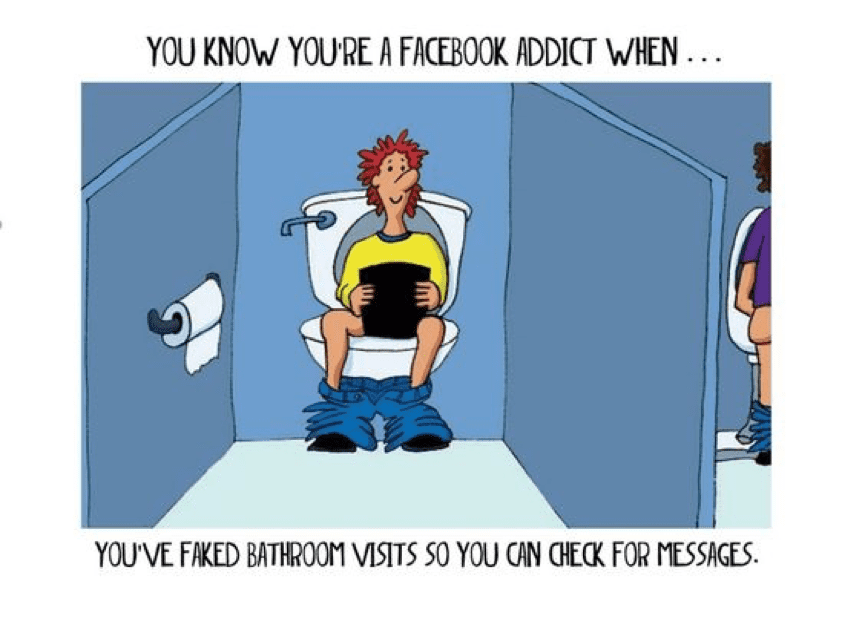12 Apr You’ve Got Facebook Open… Don’t You?

Today, Facebook has a near-ubiquitous presence in Australian life. We use it nearly everywhere and at nearly every moment- when we wake up and lie down; while we’re on the bus or in the car, on the toilet (men especially– who would’ve thought?), on the couch, or on the job; before, during and after a meal; when we’re without friends or when we’re with friends- I could go on.
Australians on Facebook
Australia has a population of over 24 million, of which 17 million are on Facebook. That means some 70% of Australians are active on Facebook. According to Sensis (2016), Australians visit Facebook 32 times a week on an average, and cumulatively spend just over half a day (12.5 hours) on Facebook during the week. That’s about 107 minutes a day. We effectively spend one whole day of each fortnight on Facebook.
Yet, the use of Facebook for business growth does not appear to have picked up. Just less than half (48%) of small businesses are on social media (Sensis 2016). Compare that to 70% of Australians who use Facebook, and you’ll notice the gap. Social media may just give your business the edge over your competitors. Even so, with small businesses increasingly using social media (the 48% figure is up from 31% in 2015), perhaps the more pertinent question is whether you can afford to fall behind.
Let’s Get Down to Business
Social media presents numerous opportunities to grow your business. Through it, you can gain insights into your customers, and customise your content to best appeal to them. You can acknowledge customer feedback, and show your commitment to customer satisfaction. You can humanise your brand and connect personally with customers, strengthening your credibility and their loyalty. By circulating your content (through likes, shares, retweets, favourites, and so on), you can raise awareness of your brand, increase your website’s traffic, improve your search engine rankings, and increase your sales and conversions. Illustrating the importance of social media to brand awareness and site traffic, a 2015 Nielsen report found that 60% of those who have discovered new information on Facebook go on to learn more, and 35% of those who have discovered a business or product on Facebook would share that with their friends. Illustrating the importance of social media to sales, 41% of social media users visit a brand’s social media profile before purchasing from their website (Sensis 2016).
On top of all of this, social media is a remarkably cost-effective platform. Creating a social media profile is free in most cases, paid advertising is relatively cheap compared to other marketing tools, and as little as six hours per week can generate notably increased brand awareness and site traffic.
The Competitive Edge on Social Media
People are flooded with all sorts of content on social media: cat videos, witty memes, article links, sponsored posts, and so on. How can you distinguish yourself from the clutter?
Here are my hot tips for gaining the competitive edge on social media.
- Post creative and engaging content. Sensis (2016) found that among social media users who had in recent months stopped following a brand, over half cited ‘Irrelevant or unappealing content’ as their reason. To engage effectively with users, your content should add value of different kinds- whether in inspiring thinking, insightful analysis and info-graphics, thoughtful humour, fun and interactive content (e.g. personality quizzes), customised images or videos (something people won’t immediately find on Google), or exclusive discounts and offers. There are several ways to make your content stand out. Think about what you might want to click on and follow up on, and what others are not regularly posting. Think about what your customers will be delighted to see or read, and will be happy to share with their networks. People can easily access foodie blogs and travelogues, memes and motivational stuff elsewhere. What would excite them about following you?
- Target your specific audience with customised content. Post content that is relevant to your industry to attract interested followers who will add value to your brand by their active engagement. Better to have 100 followers who actively engage with your posts, than 1000 followers who couldn’t care less.
- Visual content is fantastically accessible. Consider this: looking at an image requires little effort, watching a video requires some effort, and reading an article requires considerable effort. Videos, for example, are a tried and tested means of making your content engaging. More than 50% of Facebook users in Australia watch a video on it every day.
- Schedule your posts. If users find you are flooding (or spamming) their feeds, their interest will fade and they will stop following you. Sensis (2016) found that among social media users who had in recent months stopped following a brand, about a fifth cited ‘Too much content’ as their reason.
- Consider paid advertising. Organic reach (the visibility of unsponsored posts) is declining, ‘not only because there’s just so darn much content out there, but also because the algorithms used by the big players have to favor paid over organic for practical reasons’ (Contently 2014). As a result, ‘paid social is the only reliable means of building a targeted and effective audience for your brand on the major networks’ (Contently 2014). Sensis (2016) found that 58% of small businesses and 98% of large businesses believe their paid advertising has been effective. Moreover, a growing number of businesses (62% of small businesses and 68% of large businesses) are convinced that social media advertising will help increase sales (Sensis 2016). Yet, only 20% and 27% of small and medium sized businesses have employed paid advertising (Sensis 2016).
Contact us today, and see how we can help you kick goals through social media.



No Comments